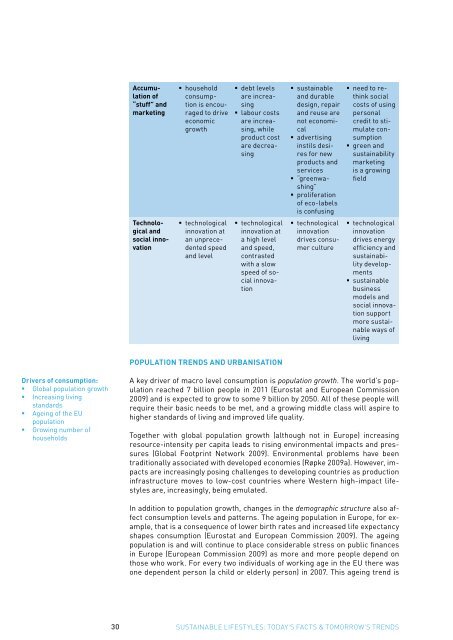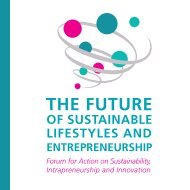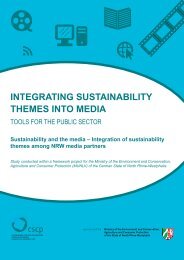today's facts & tomorrow's trends - SPREAD Sustainable Lifestyles ...
today's facts & tomorrow's trends - SPREAD Sustainable Lifestyles ...
today's facts & tomorrow's trends - SPREAD Sustainable Lifestyles ...
You also want an ePaper? Increase the reach of your titles
YUMPU automatically turns print PDFs into web optimized ePapers that Google loves.
Accumulation<br />
of<br />
“stuff” and<br />
marketing<br />
• household<br />
consumption<br />
is encouraged<br />
to drive<br />
economic<br />
growth<br />
• debt levels<br />
are increasing<br />
• labour costs<br />
are increasing,<br />
while<br />
product cost<br />
are decreasing<br />
• sustainable<br />
and durable<br />
design, repair<br />
and reuse are<br />
not economical<br />
• advertising<br />
instils desires<br />
for new<br />
products and<br />
services<br />
• “greenwashing”<br />
• proliferation<br />
of eco-labels<br />
is confusing<br />
• technological<br />
innovation<br />
drives consumer<br />
culture<br />
• need to rethink<br />
social<br />
costs of using<br />
personal<br />
credit to stimulate<br />
consumption<br />
• green and<br />
sustainability<br />
marketing<br />
is a growing<br />
field<br />
Technological<br />
and<br />
social innovation<br />
• technological<br />
innovation at<br />
an unprecedented<br />
speed<br />
and level<br />
• technological<br />
innovation at<br />
a high level<br />
and speed,<br />
contrasted<br />
with a slow<br />
speed of social<br />
innovation<br />
• technological<br />
innovation<br />
drives energy<br />
efficiency and<br />
sustainability<br />
developments<br />
• sustainable<br />
business<br />
models and<br />
social innovation<br />
support<br />
more sustainable<br />
ways of<br />
living<br />
Population <strong>trends</strong> and urbanisation<br />
Drivers of consumption:<br />
• Global population growth<br />
• Increasing living<br />
standards<br />
• Ageing of the EU<br />
population<br />
• Growing number of<br />
households<br />
A key driver of macro level consumption is population growth. The world’s population<br />
reached 7 billion people in 2011 (Eurostat and European Commission<br />
2009) and is expected to grow to some 9 billion by 2050. All of these people will<br />
require their basic needs to be met, and a growing middle class will aspire to<br />
higher standards of living and improved life quality.<br />
Together with global population growth (although not in Europe) increasing<br />
resource-intensity per capita leads to rising environmental impacts and pressures<br />
(Global Footprint Network 2009). Environmental problems have been<br />
traditionally associated with developed economies (Røpke 2009a). However, impacts<br />
are increasingly posing challenges to developing countries as production<br />
infrastructure moves to low-cost countries where Western high-impact lifestyles<br />
are, increasingly, being emulated.<br />
In addition to population growth, changes in the demographic structure also affect<br />
consumption levels and patterns. The ageing population in Europe, for example,<br />
that is a consequence of lower birth rates and increased life expectancy<br />
shapes consumption (Eurostat and European Commission 2009). The ageing<br />
population is and will continue to place considerable stress on public finances<br />
in Europe (European Commission 2009) as more and more people depend on<br />
those who work. For every two individuals of working age in the EU there was<br />
one dependent person (a child or elderly person) in 2007. This ageing trend is<br />
30<br />
SUSTAINABLE LIFESTYLES: TODAY’S FACTS & TOMORROW’S TRENDS
















